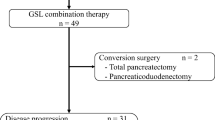Abstract
Introduction: Single agent gemcitabine (GEM) is the standard treatment of pancreatic adenocarcinoma. Celecoxib is a selective cyclooxygenase-2 (COX-2) inhibitor. Recent studies in human pancreatic tumor cell lines suggest an involvement of COX-2 in tumor-dependent angiogenesis and provide the rational for inhibition of the COX pathway as an effective therapeutic approach. The aim of this study is to evaluate the toxicity and activity of gemcitabine plus celecoxib. Patients and methods: Forty-two consecutive patients with histologically or cytologically confirmed pancreatic adenocarcinoma entered the trial. Twenty-six patients (pts) were metastatic, 16 pts had locally advanced disease. The schedule consisted of GEM 1,000 mg/m2 (as a 30 min iv infusion) on days 1, 8 every 3 weeks and celecoxib 400 mg bid. Results: Four pts (9%) achieved a partial response and 26 (62%) had stable disease, gaining a total disease control in 30 pts (71% [95% CI, 58–84%]). Overall clinical benefit response was experienced by 23 pts (54.7% [95%CI, 38.6–70.1%]). Neither grade 4 neutropenia nor grade 3–4 thrombocytopenia was observed. Grade 3 neutropenia was detected in 19% of pts. Grade 3 non-hematological toxicity was as follows: hepatic toxicity 7%, nausea 2.3%. Three pts (7%) and 5 pts (12%) had respectively a minimum creatinine increase and edema. Median survival was 9.1 months (95% CI, 7.5–10.6 months). Conclusion: GEM in combination with celecoxib showed low toxicity, good clinical benefit rate and good disease control. Further clinical investigation is warranted.

Similar content being viewed by others
References
Greenlee RT, Murray T, Bolden S et al (2000) Cancer statistics, 2000. CA Cancer J Clin 50:7–33
Burris HA, Moore MJ, Andersen J et al (1997) Improvements in survival and clinical benefit with gemcitabine as first-line chemotherapy in patients with advanced pancreas cancer: a randomised trial. J Clin Oncol 15:2403–2413
Moskaluk CA, Hruban RH, Kern SE (1997) p16 and K-ras mutations in the intraductal precursors of human pancreatic adenocarcinoma. Cancer Res 57:2140–2143
Tucker ON, Dannenberg AJ, Yang EK et al (1999) Cyclooxygenase-2 expression is up-regulated in human pancreatic cancer. Cancer Res 59:987–990
Koki AT, Leahy KM, Masferrer JL (1999) Potential utility of COX-2 inhibitors in chemoprevention and chemotherapy. Exp Opin Invest Drug 8:1623–1638
Ding XZ, Hennig R, Asrian TE (2003) Lipoxygenase and cyclooxygenase metabolism: new insights in treatment and chemoprevention of pancreatic cancer. Molec Cancer 2:10–22
Koki AT, Masferrer JL (2002) Celecoxib: a specific COX-2 inhibitor with anticancer properties. Cancer Control 9:28–34
Gately S, Li WW (2004) Multiple role of COX-2 in tumour angiogenesis: a target for antiangigenic therapy. Semin Oncol 31:2–11
Sonoshita M, Takaku K, Sasaki N et al (2001) Acceleration of intestinal polyposis through prostaglandin receptor EP2 in Apc (Delta 716) knockout mice. Nat Med 7:1048–1051
Gately S (2000) The contributions of cyclooxygenase-2 to tumor angiogenesis. Cancer Metastasis Rev 19:19–27
Ding XZ, Tong WG, Adrian TE (2000) Blockade of cyclooxygenase-2 inhibits proliferation and induces apoptosis in human pancreatic cancer cells. Anticancer Res 20:2625–2631
Wei D, Wang L, He Y et al (2004) Celecoxib inhibits vascular endothelial growth factor expression and reduces angiogenesis and metastasis of human pancreatic cancer via suppression of Sp1 transcription factor activity. Cancer Res 64:2030–2038
Kaplan EL, Meier P (1959) Non-parametric estimation from incomplete observations. J Am Stat Assoc 53:457–481
Cox DR (1970) The analysis of binary data. Methnen, London
Steinbach G, Lynch PM, Phillips RK et al (2000) The effect of celecoxib, a cycloxygenase-2 inhibitor, in familial adenomatous polyposis. N Engl J Med 342:1946–1952
Bissonnette M, Khare S, von Lintig FC et al (2000) Mutational and non-mutational activation of p21ras in rat colonic azoxymethane-induced tumors: effects on mitogenic-activated protein kinase, cyclooxygenase-2, and cyclin D1. Cancer Res 60:4602–4609
Subbaramaiah K (1999) Inhibition of cyclooxygenase-2 gene expression by p53. J Biol Chem 274:10911–10915
Yip-Schneider MT, Bernard DS, Billings SD et al (2000) Cyclooxygenase-2 expression in human pancreatic adenocarcinomas. Carcinogenesis 21:139–146
Leahy KM, Ornberg RL, Wang Y et al (2002) Cyclooxygenase-2 inhibition by celecoxib reduces proliferation and induces apoptosis in angiogenic endothelial cells in vivo. Cancer Res 62:625–631
Cascinu S, Silva RR, Barni S et al (1999) A combination of gemcitabine and 5-fluorouracil in advanced pancreatic cancer, a report from the Italian group for the study of digestive tract cancer (GISCAD). Br J Cancer 80:1595–1598
Hidalgo M, Castellano D, Paz-Ares L et al (1999) Phase I–II study of gemcitabine and fluorouracil as a continuous infusion in patients with pancreatic cancer. J Clin Oncol 17:585–592
Louvet C, André T, Hammel P et al (2001) Phase II trial of bimonthly leucovorin, 5-fluorouracil and gemcitabine for advanced pancreatic adenocarcinoma (FOLFUGEM). Ann Oncol 12:675–679
Louvet C, André T, Lledo G et al (2002) Gemcitabine combined with oxaliplatin in advanced pancreatic adenocarcinoma: final results of a GERCOR multicenter phase II study. J Clin Oncol 20:1512–1518
Heinemann V, Quietzsch D, Gieseler F et al (2003) A phase III trial comparing gemcitabine plus cisplatin vs gemcitabine alone in advanced pancreatic carcinoma. Proc Am Soc Clin Oncol (abstr 1003) 22:250
Author information
Authors and Affiliations
Corresponding author
Rights and permissions
About this article
Cite this article
Ferrari, V., Valcamonico, F., Amoroso, V. et al. Gemcitabine plus celecoxib (GECO) in advanced pancreatic cancer: a phase II trial. Cancer Chemother Pharmacol 57, 185–190 (2006). https://doi.org/10.1007/s00280-005-0028-1
Received:
Accepted:
Published:
Issue Date:
DOI: https://doi.org/10.1007/s00280-005-0028-1




